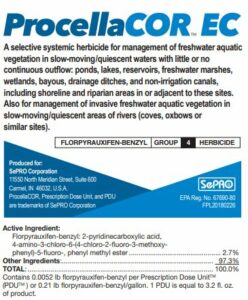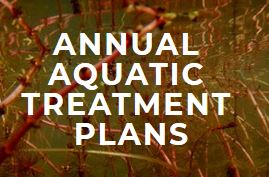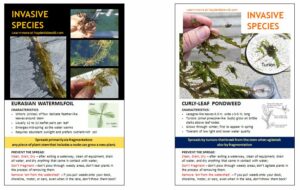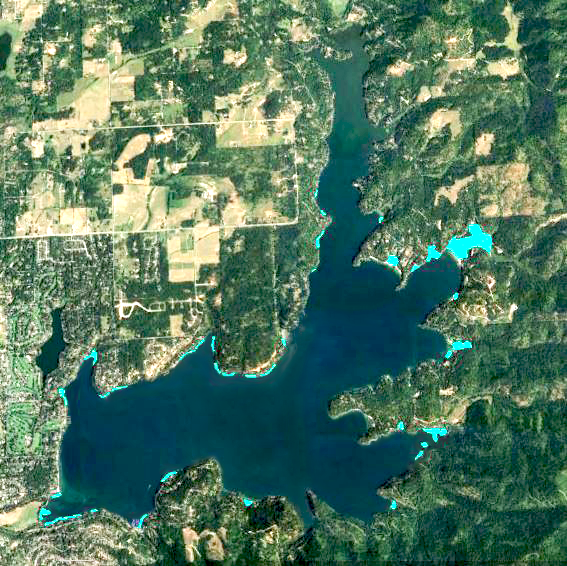 ProcellaCOR – A New Herbicide
ProcellaCOR – A New Herbicide
ProcellaCOR carries a promise of long-term control for milfoil. Based on tests conducted by the Army Corps of Engineers, NPDES-permitted applicators may now use this new herbicide in North Idaho waters. In the Pend Oreille River, where the tests took place in 2018 and analysis is on-going, milfoil treated with ProcellaCOR has shown scant regrowth.
ProcellaCOR is a systemic herbicide. It works inside the plant system to disrupt normal cell function to the degree that the plant dies. Aquatic plants rapidly absorb the herbicide through floating or submersed leaves and shoots. “ProcellaCOR has an extremely short contact exposure time requirement, has an affinity for target species like Eurasian milfoil, and moves into the plant rapidly.“ (1) Note that this isn’t a broad-spectrum herbicide; it won’t kill all of the naturally-occurring plants that might have survived the vigorous milfoil competition.


Treatment Areas in the Main-body of the Lake
While the North Arm was under the microscope for Curly-leaf Pondweed this spring, some parts of the main body of the lake, like Mokins and O’Rourke Bays, were seeing significant milfoil growth. Those areas are now the target of attention. Any of the narrow, shallow shorelines around the main body of the lake that harbor milfoil will also receive treatment.
What about the North Arm? ISDA surveys have confirmed that the North Arm is acceptably free of invasive/noxious weeds. It will not be treated further this summer.
Check ISDA’s Annual Aquatic Treatment Plans webpage to determine the exact treatment locations.
Water-use Restrictions
According to the label, water-use restrictions are minimal:
- NO drinking water restrictions – you may drink the lake water as usual.
- NO recreation restrictions – you may swim, ski, etc. in the lake immediately after application.
- NO turf irrigation restrictions – you may water your lawns with treated lake water.
- YES! There are broad-leaf, ornamental, and crop plant restrictions! ProcellaCOR levels must be below 2 parts-per-billion.
ISDA will take water samples on the third day after the treatment. Results will be known and published on the fourth day. Again, check ISDA’s Annual Aquatic Treatment Plans webpage to confirm treatment results.
Since restrictions are so light, ProcellaCOR applications require very little notification. Notices will appear at Honeysuckle Beach 14 days before treatment. Water-rights-holders and residents will receive notices via door hangers three days before. Look for them on the 19th.
ProcellaCOR PLUS Prevention
While ProcellaCOR is the most exciting invasive-weed treatment to come along in decades, it is one strategy in a larger weed-management plan. ‘Ultimately, ProcellaCOR is most effective when used alongside proactive strategies to reduce the spread of invasive plants. Routinely inspecting and cleaning boats and other equipment used in and around water following use, educating community members about plant identification and preventing the spread of invasive and noxious species, and partnering with experts … to manage your water quality will go a long way in the battle against invasive species.” (2)
To know the two most prominent aquatic invasive plants in Hayden Lake, print and post these Invasive Species Cards:


References - find more on the web:
Washington State Lake Protection Association
Solitude Lake Management







2 Responses
Great news! How about you put some blue on the areas up by Sportsmans Access? Can barely get a boat through there…
Thanks for your comment, Josh. As of about July 31, the north end of the lake was remarkably clear of weeds. This is attributed to the weed treatment that ISDA implemented from April through June. Look back through the BLOG for relevant posts that explain the type of herbicide used and the expected impacts. Residents are reporting that it’s the best August, as far as weeds go, in their recollections. I believe that you will be able to get your boat through there now.
Comments are closed.